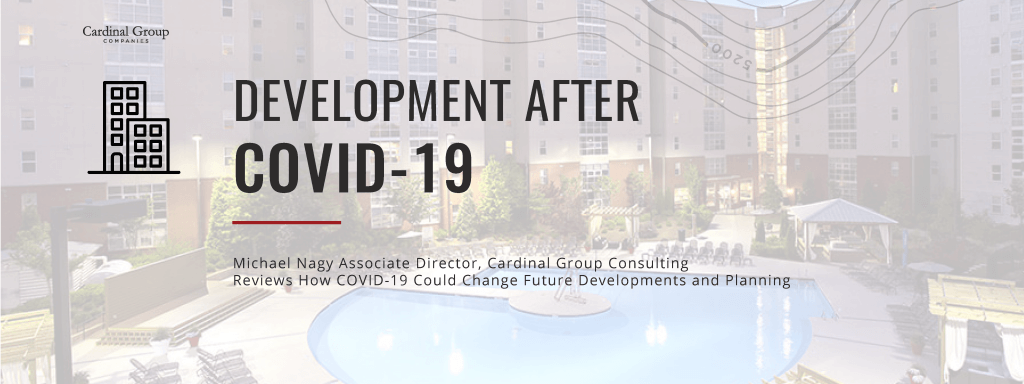Spotlight: Development After COVID-19
COVID-19 has changed the way the world works, this is an undeniable fact that many people and businesses are grappling with at the moment. Although many believe the impacts of COVID-19 will be far-reaching, nobody can predict just how impactful they might be to life in the future. Cardinal Group Consulting has been pondering in recent weeks, what sort of changes might COVID-19 inspire at new communities under construction, in the planning stages and into the future? How will changing work habits affect lifestyle preferences and what can developers do to best meet the needs of their future residents? While things continue to change at a rapid pace, we’ve had some thoughts on ways new developments can adapt in this changing environment that are low-impact to the development but high-impact for residents.
Package storage: We’ve consulted on a number of new developments in the months leading up to COVID-19 and package storage always came up as something that would be nice to have. Maybe it’s a common amenity in the market and therefore necessary to be competitive, maybe the developer is trying to trim some fat on their budget, and removing some of the lockers is an easy VE item. Cardinal has spoken at length with several of the big players in the space including Amazon, Luxer, and Parcel Pending to get their take on issues and solutions for new and existing communities moving forward. One company has seen a 15% increase in package volume through the month of April, which may not seem like much, but at a community with 300 units, this could easily lead to overflows and all the headaches that come from lost, damaged or stolen packages. Previously, a 1:2.5 locker-to-unit ratio was suggested, but many of us might have deemed that unnecessary. Hand up, Cardinal suggested a developer who was running over budget cut out some of their proposed storage capacity in order to save ~$10,000 back in January. That seems like a short-sighted suggested now, given the immense amount of package volume communities have been experiencing. What this has illustrated to Cardinal isn’t the necessity to be right 100% of the time or a preternatural ability to predict the future, but rather, the ability for communities to be flexible.
Flexible Spaces: It’s important to design amenity spaces with the ability to grow and change with the requirements of the world. While the community mentioned previously may deliver with too few package lockers, the space was designed to allow for growth and additional lockers in the future. Similar flexibility should be incorporated into lobbies, clubhouse, fitness centers, and other amenities.
Smaller Defined Seating Areas: One popular trend in multifamily has been the incorporation of “co-working” space into amenities. By definition, these spaces are supposed to be open in order to encourage interaction between users, but that doesn’t work so well when residents are trying to keep their distance. Something Cardinal has been suggesting to developers even before COVID-19 was the implementation of smaller, defined seating and working areas. While features like phone booths and huddle pods were originally designed for private phone calls and small meetings, they can now serve as vital work-from-home stations for people who don’t have the required space in their unit. We have had these features at our Headquarters for years and they are constantly in use by our team members. Another feature that might make sense is instead of one long table in a lobby designed to accommodate 8 to 10 residents, have two tables designed for 4 residents with more space between each seat or “work station”.
Hand Sanitizing Stations: This is an easy one, and is likely something already being explored. Touchless hand sanitizing dispensers in the fitness center, near pet runs, and at coffee machines are an easy way to show residents we care about their health and well being.
Virtual Connectivity: Virtual Connectivity has become a staple of our personal and professional lives in recent weeks. At Cardinal, we’ve had meetings, happy hours, collaboration lunches, and yoga sessions. These have served to keep us working towards our shared goals, but most importantly, they’ve kept us connected and helped create a sense of community among team members. This is exactly what Cardinal strives to create at each community we manage: a connection that brings people together and makes where they live more than just an apartment. Virtual connections are probably here to stay, and as such, communities need to adjust their offerings. Virtual tours are essential now, but they’re also great for prospective residents who don’t live in the area and Cardinal has been implementing these at communities we manage for a long time. Other virtual connections, like a virtual fitness class login for each resident, so they can do a workout in-unit, will need to be balanced with engaging in-person events moving forward to continue building that sense of community that inspires residents to live at Cardinal managed communities year after year.
Cardinal Group is a fully integrated real estate firm offering management, consulting, construction, marketing, and investment services for student housing and multi-family real estate. Want to learn more about Cardinal’s experience and how we can add value to your community, or hear our take on an industry topic? Give us a call or send an email (info@cardinalgroup.com), we’d love to chat!


